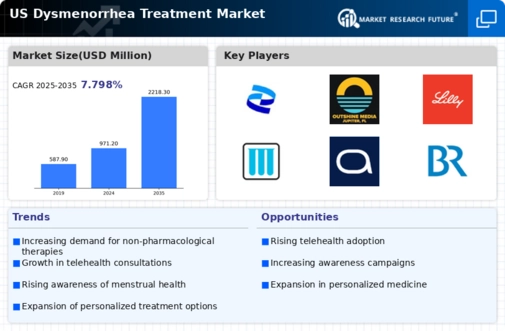The US Dysmenorrhea Treatment Market is characterized by a diverse range of pharmaceutical products and therapies aimed at alleviating painful menstrual cramps that affect a significant portion of the female population. This market has gained considerable attention due to the increasing awareness of women's health issues and the growing demand for effective treatment options. Various companies are engaged in developing over-the-counter and prescription medications, including NSAIDs, hormonal treatments, and alternative therapies. The competitive landscape in this market is dynamic, with several key players striving to innovate and address the unmet needs of patients.
These companies are focused on research and development, forging strategic partnerships, and expanding their market presence to capture a larger share of this segment, tailoring their offerings to cater to both physicians and patients.
Pfizer
Pfizer has established a strong foothold within the US Dysmenorrhea Treatment Market by offering a portfolio of effective medications aimed at managing menstrual pain. The company leverages its extensive experience and brand recognition to provide well-researched solutions that cater to the diverse needs of patients. Pfizer's strengths lie in its robust distribution capabilities, ensuring widespread availability of its products across pharmacies and healthcare facilities nationwide. The company's commitment to innovation is reflected in its continuous investment in the development of new formulations and delivery methods, further enhancing its presence and credibility among healthcare professionals and patients.
This focus on patient-centered care allows Pfizer to maintain a competitive edge in addressing the challenges posed by dysmenorrhea.
Amgen
Amgen operates within the US Dysmenorrhea Treatment Market with a keen emphasis on biologic therapies and innovative treatment options. Known for its focus on research and development, Amgen has positioned itself as a leader in the field by introducing advanced therapies specifically targeting dysmenorrhea and associated conditions. The company’s strengths are bolstered by its strong financial backing and a history of strategic mergers and acquisitions, which have enhanced its product offerings and market reach. Amgen emphasizes partnerships with healthcare professionals to understand patient needs better and to ensure accessibility to its key products.
With a keen understanding of the healthcare landscape in the US, Amgen continues to drive innovation, aiming to improve treatment outcomes and contribute to the overall growth of the Dysmenorrhea Treatment Market.
























Leave a Comment